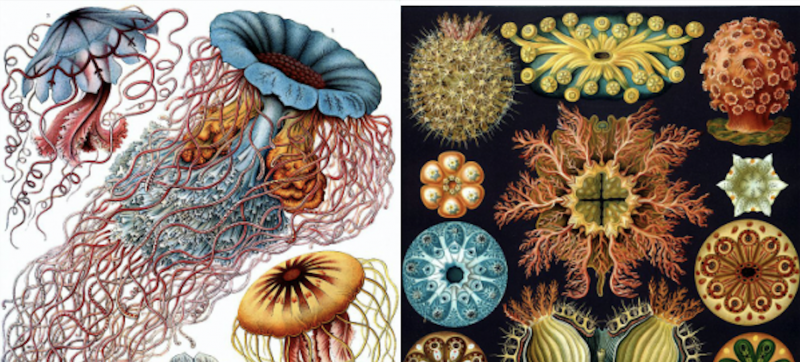
"But dur­ing the first, say, 200 years of mod­ern sci­ence, sci­en­tists were "nat­ur­al philosophers"-often as well versed in log­ic, meta­physics, or the­ol­o­gy as they were in math­e­mat­ics and tax­onomies. And most of them were artists too of one kind or anoth­er."
"Ernst Hein­rich Haeck­el, a Ger­man biol­o­gist and nat­u­ral­ist, philoso­pher and physi­cian, and pro­po­nent of Dar­win­ism who described and named thou­sands of species, mapped them on a genealog­i­cal tree, and "coined sev­er­al sci­en­tif­ic terms com­mon­ly known today," This is Colos­al writes, "such as ecol­o­gy, phy­lum, and stem cell." That's an impres­sive resume, isn't it? Oh, and check out his art-his bril­liant­ly col­ored, ele­gant­ly ren­dered, high­ly styl­ized depic­tions of "far flung flo­ra and fau­na," of microbes and nat­ur­al pat­terns, in designs that inspired the Art Nou­veau move­ment."
During the first two centuries of modern science, scientists commonly functioned as natural philosophers with training in logic, metaphysics, theology, mathematics, and taxonomy. Scientific practitioners frequently learned drawing to illustrate discoveries before photography and computer imaging existed. Many scientists produced accomplished art and music alongside their research. Ernst Heinrich Haeckel exemplified this blend as a German biologist, naturalist, philosopher, and physician who described thousands of species, mapped genealogical trees, coined terms like ecology, phylum, and stem cell, and created highly stylized illustrations that influenced the Art Nouveau movement. The disciplines later became professionally separate.
Read at Open Culture
Unable to calculate read time
Collection
[
|
...
]